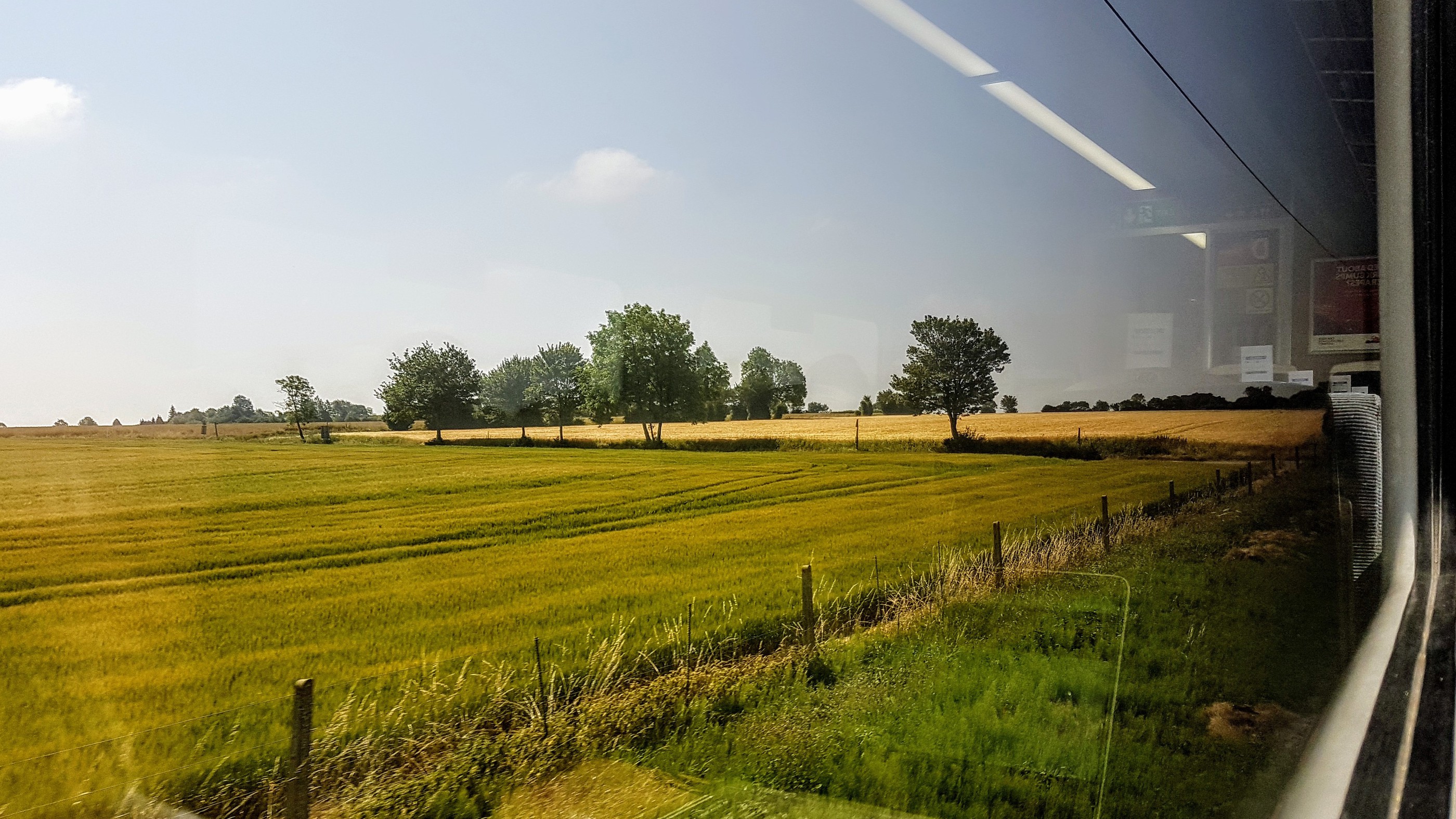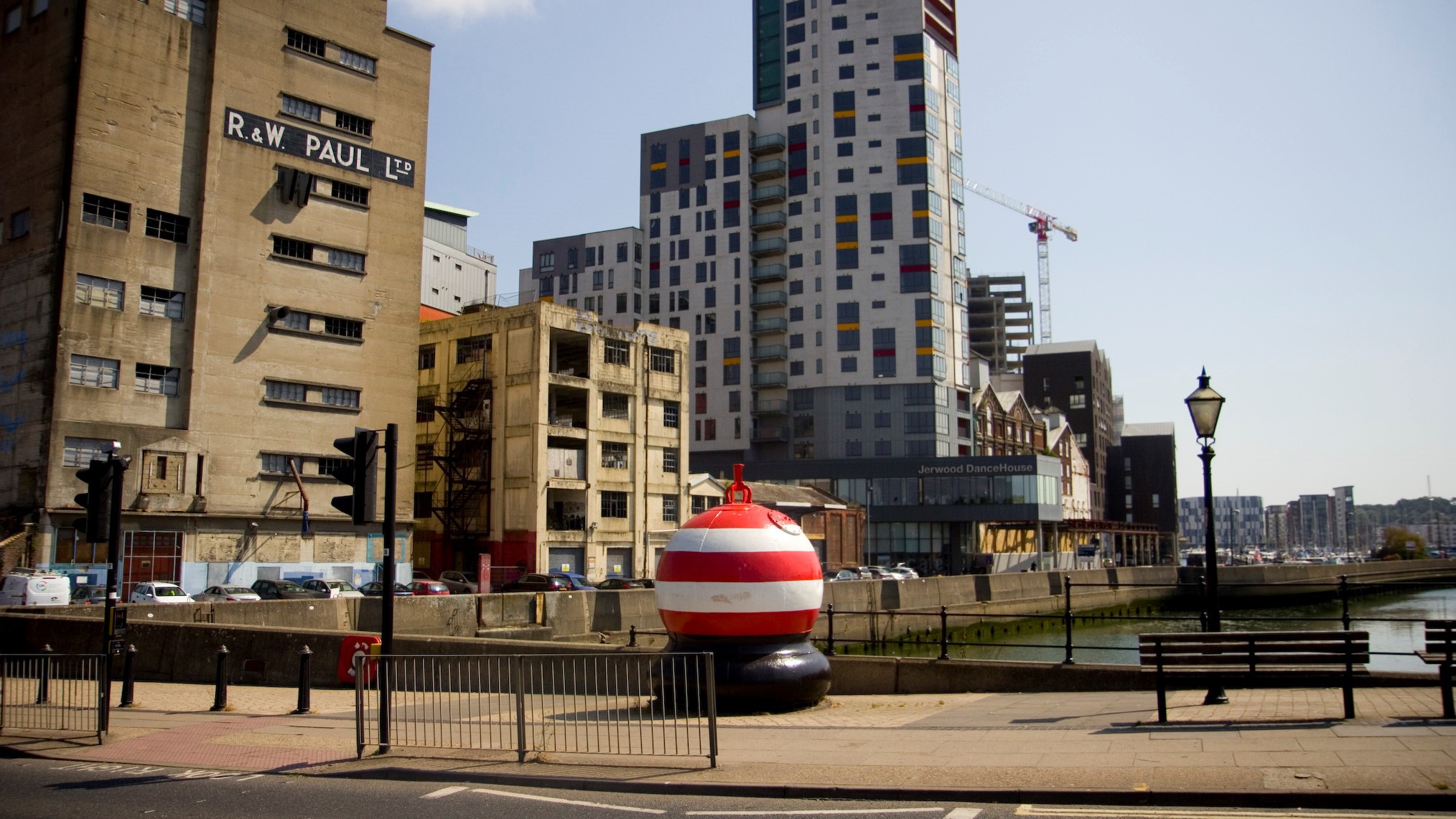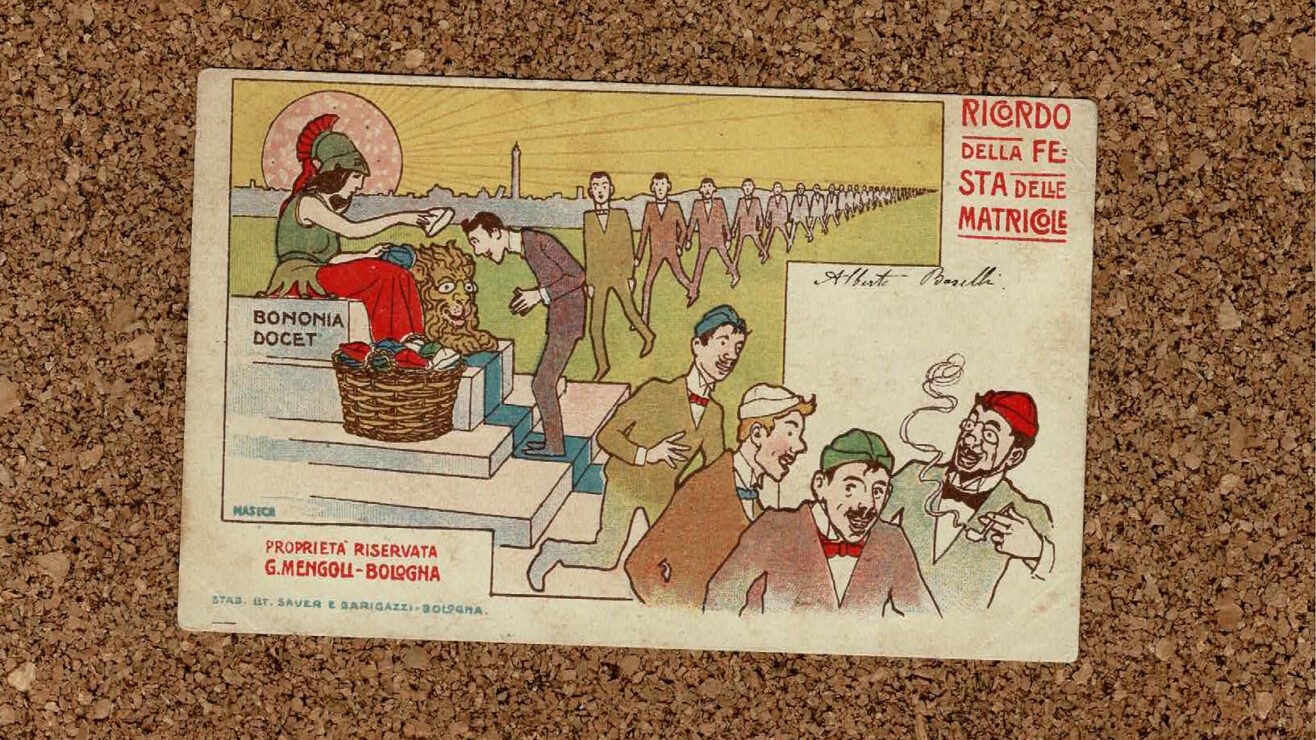It was a 38-minute train ride across the flat landscape from Norwich to Ipswich, in one of the old trains (soon to be replaced) on a line still set to 1960s specifications with a maximum speed of up to 100 mph.

On arriving at what is apparently “England’s oldest (continuously inhabited) town”, you’re immediately greeted with the sight of Portman Road, the home stadium of Ipswich Town F.C. since 1884.

The campus is a mile-long walk by the River Orwell and the regenerating waterfront.

There are apparently plans afoot to improve the journey, though it’s perfectly pleasant on a sunny day.

The main University of Suffolk campus is a cluster of modern buildings in the North-East corner of the port, dominated by the blue-and-white Waterfront building, opened a decade ago at a cost of £35m.

The island opposite is the site of the busy Port of Ipswich, with some ambitious £139m regeneration and infrastructure plans under discussion. In the 19th Century Ipswich Port was briefly the largest wet dock in the UK and today is the country’s biggest grain export hub. The country’s busiest container port – at Felixstowe – is less than half an hour’s drive away.

Over the road is the university’s recently-refurbished Atrium building, featuring a virtual radiotherapy training centre, 3D printers, and computer game design suites. It also hosts the Ipswich Waterfront Innovation Centre (co-funded with the New Anglia Local Enterprise Partnership [LEP]) and the Suffolk Centre for Female Entrepreneurship. These – and the part-EU-funded New Anglia Growth Hub nearby – aim to encourage local entrepreneurship with grants, training, desk space and other support. Ensuring such funding is maintained post-Brexit will clearly make a big difference here.

To the right of the Atrium (in the below picture) are the art school studios, offering facilities for painting, sculpture, photography and film.

Helen Langton, the new vice chancellor of this new university, has an office overlooking the pretty waterfront. In separate conversations with Langton and Tim Greenacre, the Registrar and Secretary, it’s clear the team have ambitious but careful plans for the future.

Know thy place
But first, a little history. In the 5th Century when the Angles (who gave us the names East Anglia and England) established control of this region they divided themselves into the North folk (of Norfolk) and the South folk (of Suffolk). The Anglo-Saxon settlement of Gyppeswyk (Ipswich) grew from an earlier Roman stronghold, receiving a royal charter from King John in 1200. It’s Suffolk’s county town and biggest urban centre. And its new university actually draws its lineage back to the Cardinal College of the Blessed Virgin Mary, first founded in the 16th Century by local lad Thomas Wolsey; Henry VIII’s lord chancellor, cardinal, reformer, diplomat, educationalist, and famously – for those of us partial to a little Hilary Mantel – Thomas Cromwell’s ally.

Over the centuries, the region’s important industries have included farming, pottery, sugar beet, sheep’s wool, and cloth. There was even a royal mint in the town for a while. But, the fortunes of Ipswich have always followed those of its ports, building ships for the King’s navy, fishing and trading around the world. Chaucer came from a wealthy family of Ipswich wine merchants and the Victorian customs house still dominates the quayside. The docks were bombed in both world wars. Another local lad, one Horatio Nelson, was High Sheriff of Ipswich when he died at the battle of Trafalgar.

The waterfront is lovely, with a mix of old buildings (some still to be redeveloped, some already restored), new builds, a photography festival, and an art gallery – the latter two involving the university. The area is slowly transforming from industrial to leisure and residential uses.

There’s also space for growth, with the university purchasing neighbouring land and expanding gradually, with an eye to the future.

When some highly-geared developers’ projects stalled after the 2008 economic crash, the port’s patient “anchor institution” made some careful long-term bets. Those stalled building sites are now under construction again, with other big long-term plans for the town including The Winerack (a mixed-use tower that had been stalled for eight years but is now back under construction) and The Hold (a £20m archive project at the university which will house part of the Suffolk Record Office).
New in town
The University of Suffolk is the first higher education institution in the county’s long and colourful history. It’s new and small but expanding. Without the “legacy issues” of its more-established peers, it’s able to be innovative and agile, offering courses directly related to regional business needs, such as cybersecurity and childhood studies, and including “sandwich” placement years. Recent course additions include politics; architecture; and, wildlife, ecology and conservations science. Course types include foundation, honours and postgraduate degrees, higher and degree apprenticeships. Despite its current size it aims to be general not specialist, offering 266 undergraduate courses and 44 postgraduate courses in 2018/19. As the sole university in Suffolk, it has a comprehensive intake, with the third-highest proportion of full-time students under 21-years-old entering university for the first time from traditionally low participation areas.
East Anglia’s five higher education institutions – including the University of Suffolk – are working in partnership with the region’s further education colleges and other stakeholders to deliver the Network for East Anglian Collaborative Outreach, as part of the government’s Network for Collaborative Outreach Programme. This relatively large-scale intervention targets 23,045 students in years 9-13 across 74 target (low HE participation) wards, for instance by basing HE “champions” in schools and colleges, providing a range of resources, and sending supportive text messages about how to apply via UCAS.
Suffolk’s status as one of the six (of 48) English ceremonial counties lacking a university first helped prompt Suffolk County Council in 2007 to approach neighbouring institutions the University of Essex (Colchester, Loughton and Southend) and the University of East Anglia (UEA, in Norwich) to form a unique collaboration along with local further education colleges and other partners. The £150m result was University Campus Suffolk (UCS), with the two “parent” universities jointly validating courses. Many of the original partner organisations – such as development agencies, HEFCE, and the learning and skills council – are now defunct. These days the in-vogue actors for such a partnership would be LEPs, mayors, and maybe even the Office for Students. Could the University of Rutland be in the pipeline?
I wondered if it was a combination of altruism and market opportunity that first drew the two local universities into the UCS project, and how a tougher and more competitive environment influenced their subsequent decisions as their “offspring” matured and found its own feet.
It took two years of trying for UCS to get teaching-degree awarding powers (TDAP – awarded November 2015) and in August 2016 it received university title – becoming the fully independent University of Suffolk.
The institution is already working to get research-degree awarding powers (RDAP). One challenge is that it has a high proportion of part-time PhD students, who take a long time to complete their studies and demonstrate the institution’s research chops. Tricky for a new provider in a part of the country that is historically underserved, and for one that is committed to giving students flexibility about how and when they study, with 1,063 part-time students. At present postgraduate research degrees are validated by UEA.
With its February intake the latest student numbers aren’t clear yet, but last academic year the university had 5,702 undergraduate students and 548 postgraduates, along with 482 staff. It also validates higher education courses for about 1,369 students across a “learning network” of three nearby partner colleges; East Coast College in Great Yarmouth (Norfolk) and Lowestoft, West Suffolk College in Bury St Edmunds, and Suffolk New College – the latter just next door to the university. It has five sites in total, two of which are in Ipswich. These local pathways into professions such as nursing and teaching can reach and engage those students – especially mature and part-time learners – no other HE providers can, overcoming barriers such as transport costs and travel times.
The institution isn’t higher education innovation funding (HEIF)-able yet due to its small size and constant formula changes, making it relatively reliant on money from the European Regional Development Fund (ERDF). The latter is used to offer local businesses start-up grants, support, and advice. Again, sound the post-Brexit klaxon. Will those in Westminster ensure such funds continue to reach Ipswich after March?
Langton is encouraging her team to make the university distinctive, asking “what do we want to be famous for?” (a key question later echoed by Graeme Wise on Wonkhe, in turn quoting Paul Temple’s 2014 book). The three-part answer for Suffolk includes teaching, research and business engagement. Teaching aims to be informed by research and developed with employers, translational (rather than basic) research centres focus on industry-relevant topics such as sustainability and cybersecurity.
Additionally, most of its broad range of courses have professional and entrepreneurial edges to them, involving employers in the curriculum, and often featuring placements, internships and professional practice modules. The university is proud of the statistic that 95% of its graduates are working or studying within six months, according to the Destinations of Leavers from HE (DLHE) survey. Students are also encouraged to develop their own Higher Education Achievement Report (HEAR) to showcase the range of skills and experiences they develop.
The prospectus claims it’s a new “type” of university, combining tradition and modernity. The tone throughout is one of personal support and embracing change. Assessment is formative and learning and teaching follows a three-step approach, with the first year of “guided learning” featuring smaller group-work on academic skills, the second “negotiated learning” year has project-based learning and collaboration, while the third year of “independent learning” has self-directed research and professional development. The back page even has a circular QR code specifically for Facebook messenger.
I imagine that smaller and newer institutions are even more focused on student recruitment than their larger and more-established peers, living closer to the wire as they build up resources, a track record and a brand.
Building on existing economic strengths
The East of England has some big plans. Unknown to most people, BT’s global research and development arm (and about 100 high-tech businesses) are based nearby at Adastral Park, with the number of research and innovation jobs planned to double to 8,000. The university already co-designs courses in computer science, computer design, and tech design with the telecoms giant. Other big local employers include financial services and insurance multinational companies such as AXA, LV and Willis Towers Watson. There are estimated to be 15,000 advanced manufacturing jobs in Suffolk and a rapidly growing biotech industry. The university even offers some integrated masters degrees in sports science with Ipswich Town Football Club.
The University of Suffolk is also trying to be “smart” in how it works with the government, the LEP, and the two two-tier local councils, playing a proactive role in the visions for Ipswich, Suffolk and East Anglia. Typically the focus is innovation and jobs through research and teaching.
Half of the capacity of Ipswich Port is focused on freight, logistics, and supply chains – often demanding graduate skills and innovative research.
Energy is another major local employer, with 986 wind turbines currently off the Suffolk shore and the world’s 2nd largest wind farm in development – aiming to be one-and-a-half times the size of the county and employing 600 people directly. Wave, tidal, solar and micro energy generation are other emerging areas providing further research and employment opportunities. Nuclear power stations Sizewell A, B – and hopefully, from 2031, C – are a fifty-minute drive away, currently employing 770 people, with a whopping 25,000 new jobs predicted. This is all on top of existing oil and gas production. The Greater Ipswich City Deal, signed in 2013, includes a focus on the skills needs of sites such as Sizewell and Felixstowe. The LEP is also the government’s Green Economy Pathfinder, focused on sustainable business practices, for instance in energy-efficient construction, with a target of 140,000 new homes in East Anglia by 2036. Given Suffolk’s low-lying nature, this all seems sensible. The university is already active in some of this activity, with plans for further engagement.
It’s also a highly rural area, with huge and well-established agricultural, food and drink industries – the nickname for the football club is “the tractor boys”. This is a sector ripe for further research, automation and efficiencies. It is also one highly-exposed to the current direction of skill-based post-Brexit immigration policy. This will all have big implications for the local workforce, creating social challenges alongside technical ones. The university has researchers and courses focused on both types of challenge.
Values and other assets
The university isn’t just building on economic strengths though. Ipswich and the surrounding area play their part in the ongoing battle for equality. Elizabeth Garrett Anderson was the first female physician, surgeon and mayor in England. She was also a prominent suffragist, campaigning alongside her sister Millicent Fawcett for equal votes and education for women. Earlier this month the university announced its first chancellor will be prominent development-academic Helen Pankhurst, great-granddaughter of Emmeline and granddaughter of Sylvia, leader of the British suffragette movement. A century since the first (propertied over-30) women were enfranchised it’s great to see this new university signalling its intent on the issue.
Modern-day Suffolk and Ipswich have pockets of severe educational underachievement and poverty, with many families without any experience of higher education at all. As an indicator of such challenges, there are two local opportunity areas, with the university involved in both – working with children from primary age, focusing on nurturing creativity and getting girls into STEM. Unemployment is higher in Ipswich than regional and national averages, and many areas of Suffolk have relatively old populations. At almost 150,000 people, the county town has a multicultural population and is one of the fastest growing urban centres in the UK. Proposals are being discussed for investing in transport infrastructure, with road capacity and congestion issues making the 75-mile journey to London at least a two-hour drive, and the rail link overdue an upgrade, with the fastest trains still taking over an hour.
The cost of living is low in Ipswich and it’s officially the sunniest and driest town in the country. The brewer Adnams is an hour’s drive away in pretty beach-hut-strewn Southwold, and closer to home the Calvors micro-brewery produces Suffolk Graduate ale in partnership with the university. There might not be any mountains in the three counties of East Anglia, but it’s not all flat, with some lovely rolling hills and heaths, as well as the renowned meandering waterways of the Broads and Fens. No wonder Constable, Gainsborough and the cartoonist Giles were charmed. With the right weather, the fifty miles of Suffolk’s beaches are hard to match and are rarely busy.
Local festivals include the Ipswich Maritime Festival, the Suffolk Show, Ip-art, PULSE, Latitude and Jimmy’s. Famed musical locals range from Benjamin Britten to John Peel, Ed Sheeran to Laura Wright, and Brian Eno to The Darkness. DanceEast in Ipswich is the region’s dance hub, attracting international performers, and offering a broad selection of performances and classes. It’s one of four theatres in town. The university’s Waterfront building has hosted the East of England’s first public contemporary art collection for the past five years.
I left yet another university feeling galvanised. In just a short space of time, the University of Suffolk has grabbed the twin challenges of teaching and research with both hands. It was being sensitive to its surroundings by growing out from historic strengths. I could see how it was already making a difference to the town, the region and beyond. But I could also see how important it is that the regulation and funding environment supports those efforts for the long term. I wish them luck.














Thank you so much for your interesting, detailed and encouraging article. Sandy Martin, MP for Ipswich
Brilliant insight into our County town. So much to celebrate.